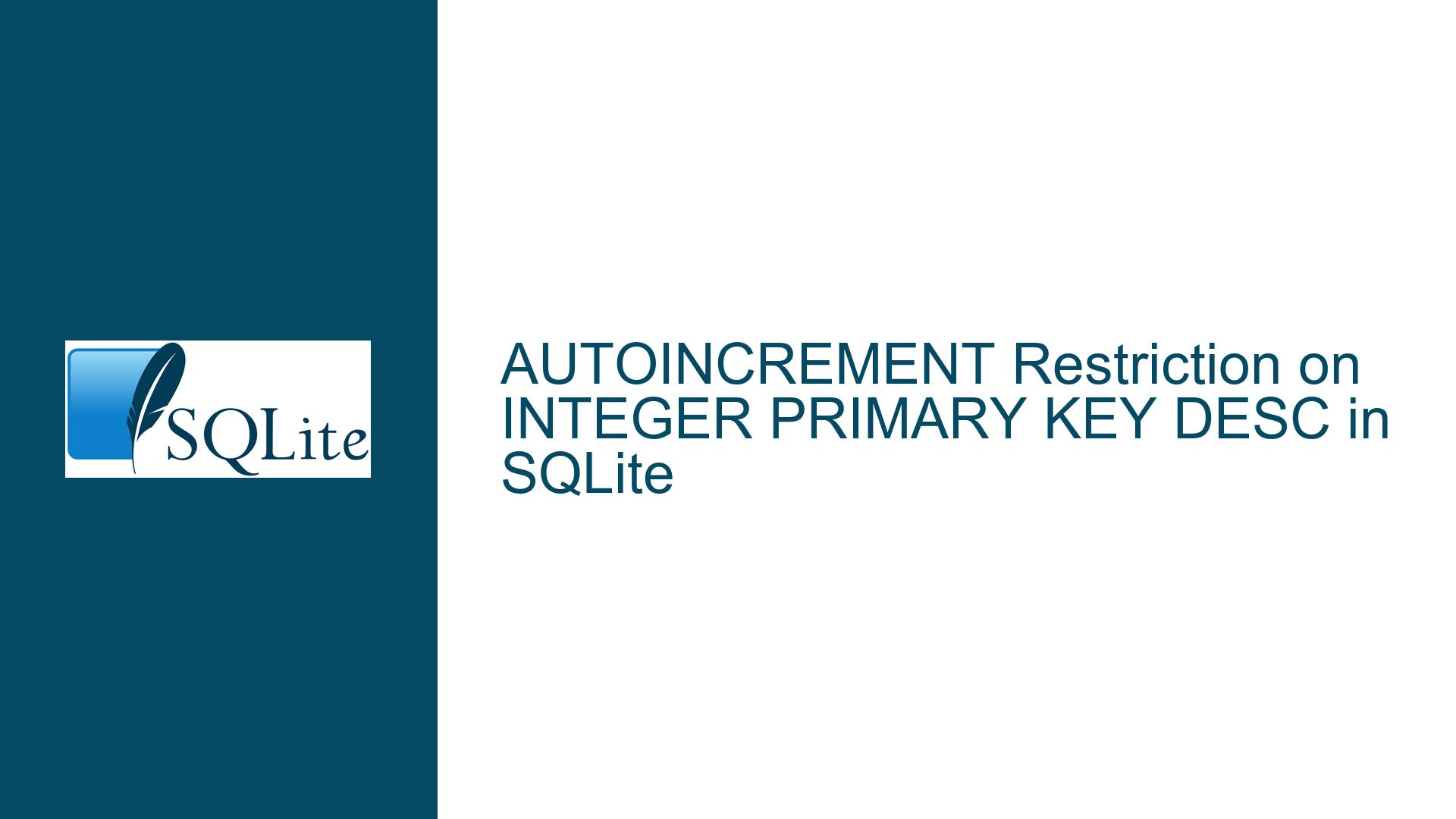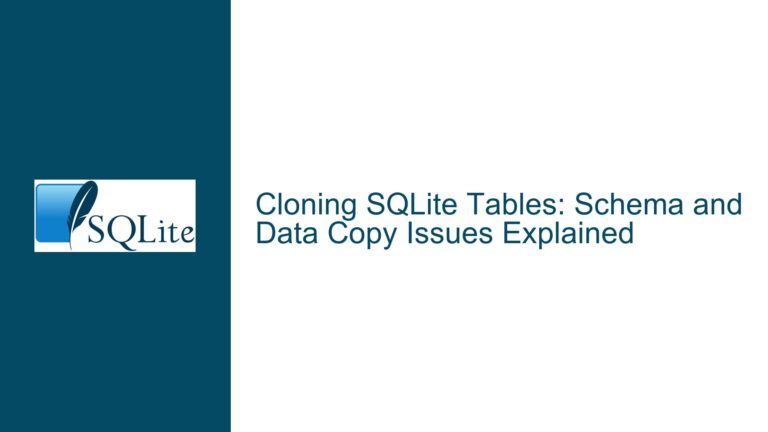AUTOINCREMENT Restriction on INTEGER PRIMARY KEY DESC in SQLite
Issue Overview: AUTOINCREMENT Constraint and PRIMARY KEY Direction
The core issue revolves around the behavior of the AUTOINCREMENT constraint in SQLite when applied to an INTEGER PRIMARY KEY column with a DESC (descending) direction. SQLite is a lightweight, serverless database engine that is widely used due to its simplicity and efficiency. One of its key features is the ability to automatically generate unique integer values for a column using the AUTOINCREMENT constraint. However, this feature comes with specific restrictions that are not immediately obvious, especially when combined with the DESC keyword.
When attempting to create a table with an INTEGER PRIMARY KEY DESC AUTOINCREMENT column, SQLite returns an error: Error: in prepare, AUTOINCREMENT is only allowed on an INTEGER PRIMARY KEY (1). This error message is misleading because it suggests that the AUTOINCREMENT constraint is only allowed on an INTEGER PRIMARY KEY, which is technically correct but does not account for the additional restriction related to the DESC direction. The error message could be improved to explicitly state that AUTOINCREMENT is not allowed on an INTEGER PRIMARY KEY DESC.
The confusion arises because SQLite allows the creation of a table with an INTEGER PRIMARY KEY ASC AUTOINCREMENT column without any issues. This discrepancy highlights a subtle but important nuance in SQLite’s implementation of the AUTOINCREMENT constraint. Understanding this behavior requires a deep dive into how SQLite handles primary keys, auto-incrementing values, and the implications of specifying a sort direction (ASC or DESC) on the primary key.
Possible Causes: SQLite’s Internal Handling of AUTOINCREMENT and PRIMARY KEY Direction
The root cause of this issue lies in SQLite’s internal mechanisms for handling auto-incrementing values and primary keys. SQLite treats an INTEGER PRIMARY KEY column as a special case, often referred to as the "rowid" column. This column is used internally by SQLite to uniquely identify rows in a table. When the AUTOINCREMENT constraint is applied to an INTEGER PRIMARY KEY column, SQLite ensures that the values generated for this column are always unique and monotonically increasing.
However, the AUTOINCREMENT constraint in SQLite is not just a simple incrementing counter. It involves a more complex mechanism that relies on a special internal table called sqlite_sequence. This table keeps track of the largest auto-incrementing value used for each table that has an AUTOINCREMENT column. When a new row is inserted into a table with an AUTOINCREMENT column, SQLite checks the sqlite_sequence table to determine the next value to use. This mechanism ensures that even if rows are deleted, the auto-incrementing values will not be reused, thus maintaining the uniqueness of the primary key.
The restriction on using AUTOINCREMENT with INTEGER PRIMARY KEY DESC stems from the way SQLite handles the sorting of primary keys. When a primary key is defined with the DESC direction, SQLite expects the values in that column to be sorted in descending order. However, the AUTOINCREMENT constraint is designed to generate values that are always increasing, which is inherently in conflict with the descending order requirement. This conflict is why SQLite does not allow the AUTOINCREMENT constraint to be used with an INTEGER PRIMARY KEY DESC column.
Additionally, SQLite’s error message could be more explicit about this restriction. The current error message, AUTOINCREMENT is only allowed on an INTEGER PRIMARY KEY, does not provide enough context to understand why the DESC direction is problematic. A more accurate error message would be: AUTOINCREMENT is not allowed on an INTEGER PRIMARY KEY DESC. This would help users quickly identify the issue and avoid confusion.
Troubleshooting Steps, Solutions & Fixes: Resolving AUTOINCREMENT and PRIMARY KEY DESC Conflicts
To resolve the issue of using AUTOINCREMENT with an INTEGER PRIMARY KEY DESC column, it is important to understand the underlying constraints and workarounds available in SQLite. Here are the steps and solutions to address this problem:
1. Understanding the Role of AUTOINCREMENT in SQLite:
The AUTOINCREMENT constraint in SQLite is designed to ensure that the values in an INTEGER PRIMARY KEY column are always unique and monotonically increasing. This is achieved by using the sqlite_sequence table to keep track of the largest value used in the auto-incrementing column. When a new row is inserted, SQLite checks the sqlite_sequence table to determine the next value to use. This mechanism prevents the reuse of values, even if rows are deleted.
However, the AUTOINCREMENT constraint is not strictly necessary in most cases. SQLite automatically assigns a unique integer value to an INTEGER PRIMARY KEY column if no value is provided during an insert operation. This behavior is similar to AUTOINCREMENT, but without the guarantee that values will not be reused. If the reuse of values is not a concern, you can omit the AUTOINCREMENT constraint and rely on SQLite’s default behavior.
2. Avoiding the Use of AUTOINCREMENT with DESC:
Since the AUTOINCREMENT constraint is not compatible with an INTEGER PRIMARY KEY DESC column, the simplest solution is to avoid using AUTOINCREMENT in this scenario. Instead, you can rely on SQLite’s default behavior for INTEGER PRIMARY KEY columns. When you define an INTEGER PRIMARY KEY DESC column without the AUTOINCREMENT constraint, SQLite will automatically assign unique integer values to the column, but these values will not be guaranteed to be monotonically increasing.
For example, you can create a table with an INTEGER PRIMARY KEY DESC column as follows:
CREATE TABLE t1 (c1 INTEGER PRIMARY KEY DESC);
In this case, SQLite will automatically assign unique integer values to the c1 column, but these values may not be in ascending order. If you need the values to be in descending order, you can manually insert values into the column or use a different approach to generate the values.
3. Using a Custom Auto-Incrementing Mechanism:
If you need to generate auto-incrementing values in descending order, you can implement a custom mechanism to achieve this. One approach is to use a trigger to generate the values for the INTEGER PRIMARY KEY DESC column. A trigger is a database object that automatically executes a specified set of SQL statements when a certain event occurs, such as an insert operation.
Here is an example of how to create a table with an INTEGER PRIMARY KEY DESC column and a trigger to generate descending values:
CREATE TABLE t1 (c1 INTEGER PRIMARY KEY DESC);
CREATE TRIGGER t1_insert_trigger
BEFORE INSERT ON t1
FOR EACH ROW
BEGIN
SELECT COALESCE(MAX(c1), 0) + 1 INTO NEW.c1 FROM t1;
END;
In this example, the trigger t1_insert_trigger is executed before each insert operation on the t1 table. The trigger calculates the maximum value in the c1 column and assigns the next value in descending order to the NEW.c1 variable. This ensures that the values in the c1 column are always unique and in descending order.
4. Improving Error Messages for Better Clarity:
To help users better understand the restrictions on using AUTOINCREMENT with INTEGER PRIMARY KEY DESC, it is recommended to improve the error message returned by SQLite. The current error message, AUTOINCREMENT is only allowed on an INTEGER PRIMARY KEY, could be enhanced to explicitly state that AUTOINCREMENT is not allowed on an INTEGER PRIMARY KEY DESC.
For example, the improved error message could be:
Error: AUTOINCREMENT is not allowed on an INTEGER PRIMARY KEY DESC.
This would provide users with a clearer understanding of the issue and help them avoid confusion when working with auto-incrementing columns in SQLite.
5. Exploring Alternative Database Designs:
If the requirement for an auto-incrementing INTEGER PRIMARY KEY DESC column is critical, it may be worth exploring alternative database designs or even considering a different database system that supports this feature. While SQLite is a powerful and versatile database engine, it has certain limitations that may not be suitable for all use cases.
For example, some other lightweight databases, such as MySQL or PostgreSQL, may offer more flexibility in defining auto-incrementing columns with different sort directions. However, it is important to weigh the trade-offs between the simplicity and efficiency of SQLite and the additional features provided by other database systems.
6. Best Practices for Using AUTOINCREMENT in SQLite:
To avoid issues with AUTOINCREMENT and INTEGER PRIMARY KEY DESC, it is important to follow best practices when designing database schemas in SQLite. Here are some recommendations:
- Use
AUTOINCREMENTonly when necessary. In most cases, SQLite’s default behavior forINTEGER PRIMARY KEYcolumns is sufficient. - Avoid using
AUTOINCREMENTwithINTEGER PRIMARY KEY DESCcolumns, as this combination is not supported by SQLite. - Consider using triggers or custom logic to generate auto-incrementing values in specific scenarios where
AUTOINCREMENTis not suitable. - Always test your database schema and queries thoroughly to ensure that they behave as expected, especially when working with auto-incrementing columns.
By following these steps and solutions, you can effectively resolve the issue of using AUTOINCREMENT with an INTEGER PRIMARY KEY DESC column in SQLite. Understanding the underlying mechanisms and constraints of SQLite’s auto-incrementing feature is key to designing robust and efficient database schemas.






